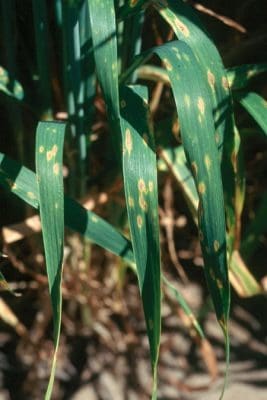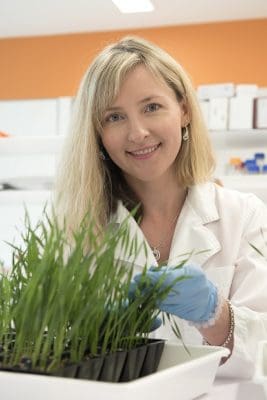A THREE-YEAR research initiative has analysed samples of yellow spot – arguably Australia’s most economically damaging wheat disease – generating valuable knowledge that will help breeders develop varieties with improved disease resistance.

The Stop the Spot initiative aims to reduce the economic impact of yellow spot disease in wheat. (Photo: GRDC)
Stop the Spot, an initiative by the Centre for Crop and Disease Management (CCDM), co-supported by Curtin University and the Grains Research and Development Corporation (GRDC), saw researchers examine 366 samples of yellow spot (Pyrenophora tritici-repentis) – also known as tan spot.
Stop the Spot, which aims to reduce the economic impact of yellow spot, was assisted by growers, advisers and scientists who sent leaf samples of the disease to the CCDM.
CCDM yellow spot program leader Caroline Moffat said the fungal isolates were now being used in ongoing work to help develop tools for wheat breeders to facilitate the release of more resistant varieties.
Dr Moffat said ‘ToxA’ – the major gene within yellow spot that causes necrosis (cell death) – was found in all ‘isolates’ of the yellow spot pathogen collected from the samples.
“This reiterates the importance of growers selecting varieties that are ‘insensitive’ to ToxA,” she said.
“Growers who choose ToxA insensitive wheat varieties may still get some yellow spot infection in their crop, but not as much as in varieties that are ‘sensitive’ to ToxA.”
Dr Moffat said a positive finding by her team was that they had confirmed that ToxA had not mutated into a different or stronger form.

CCDM yellow spot program leader Caroline Moffat says fungal isolates sourced from the Stop the Spot initiative are being used in ongoing work to help develop tools for wheat breeders to facilitate the release of more resistant wheat varieties. (Photo: CCDM)
“If growers avoid sowing ToxA sensitive varieties, they can help minimise the risk of ToxA mutating into a more potent form in the future,” she said.
Dr Moffat also encouraged growers to avoid, where possible, growing wheat on wheat stubble, with 62 per cent of samples coming from paddocks that had previously been sown to wheat.
“This result is not surprising as growing wheat in a previously infected paddock gives the pathogen the perfect opportunity to infect next season’s crop,” she said.
Dr Moffat said there were two other known effectors – ToxB and ToxC – but Stop the Spot did not detect ToxB in the samples submitted.
“This is good news, as ToxB causes a lot of damage on wheat crops overseas,” she said.
“Even so, it is still a major biosecurity risk to Australian wheat crops, so it is extremely important that we continue to monitor the yellow spot pathogen for this effector.”
Dr Moffat said an interesting finding from Stop the Spot was that about half of yellow spot-infected samples came from varieties rated moderately resistant or moderately resistant/moderately susceptible – such as Mace and Corack.
“These more resistant varieties are not damaged by ToxA as they do not possess the ToxA sensitivity gene,” she said.
“This tells us that there are more effectors out there that are doing damage, such as ToxC and others not yet identified. Thanks to the many samples sent in we are now working to discover what these are.”

HAVE YOUR SAY